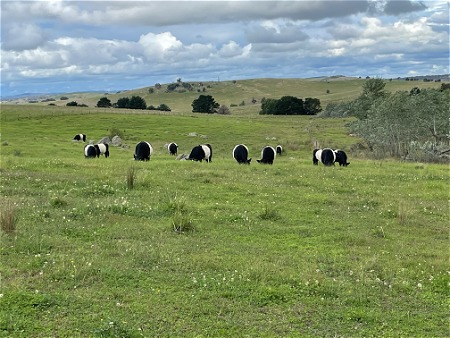Our Story
We first started breeding Belted Galloway cattle in 2009 with the purchase of eleven purebred heifers from two Southern Tableland's breeders, Pyree Park and Agricolae. Although at that time we were not interested in stud breeding we ensured the animals purchased were able to be registered as stud cattle. One of the heifers came to us pregnant and in March 2010 we had our first bull, Nurrenyen DAC.
The Belties were a great choice because they had the following characteristics:
efficient feed converters (do-ability),
indiscriminate grazers,
easy birthing (calveability),
good mothers,
great taste and marbling, and
they look good.
Initially, we were not interested in showing so the heifers were put to a commercial bull and the progeny were sold to other commercial breeders or to market. Over time we decided that we should breed up to increase the percentage of the Belted Galloway in our cattle and, after registering the herd with Galloways Australia, we started to lease stud bulls to put across the herd. In addition to Nurrenyen DAC we used two bulls from Harwood Rural, Jandrew Eli and Marananga Heath.
In 2016 we decided that we should work toward showing so we engaged Sam Croker of Rural Opps based in Goulburn to work with us to develop the herd to the stage where we could confidently show animals. That time came in 2019 when we entered Nurrenyen Newton into our first cattle show.
That first show was the Crookwell A P and H Show. At that show, Newton was awarded Champion Junior Belted Galloway Bull and Grand Champion Bull Other Recognised Breeds. He went on to be Champion Junior Belted Galloway Bull and Grand Champion Belted Galloway Bull at the Galloway family feature cattle show at Royal Canberra, and Reserve Champion Bull, Other Recognised Breeds at the Royal Sydney Show in that year.
In 2018 we continued to develop the herd through the use of A.I. and in 2019 Newton was joined to those cows and heifers to which he isn't related.
In 2024 with Nurrenyen Newton’s retirement, we will be assessing one of the progeny from our AI programme using Longfield Viper semen, Nurrenyen Thornhill. If he passes muster he will become our standing sire.
Regeneratively Grown Diverse Pastures
Since its establishment, Nurrenyen Belties has adopted farming techniques to regenerate the soil and produce nutrient-dense meat.
These methods include
1. Rotational grazing - from the beginning, by subdividing the paddocks into areas of 1 to 7 hectares, we were able to rotate the animals through the paddocks regularly based on the assessment of the quality and quantity of pasture
2. Constructing interventions in the landscape or waterways to slow or capture the flow of water increasing water retention
3. Fencing off waterways and implementing water reticulation to all the paddocks
4. Revegetating the property through planting tree lanes of the native yellow box community, and
5. Direct-drill pasture sowing.
Gradually over time, we have adopted more techniques to use the animals to improve the soil microbial ecology and regenerate the landscape. These include
1. applying only organic composts, fertilizers and bio-amendments and ceasing the use of synthetic chemical inputs such as fertilizers and herbicides,
2. encouraging natural biological cycles and nutrient transfer, and
3. implementing time-controlled planned grazing based on the rest period for the grazed pasture (adaptive multi-paddock grazing).
Through these techniques we develop the soil microbial ecology and grow healthy multi-species perennial pasture. These pastures develop a symbiotic relationship with the soil microbiology leading to increased organic carbon and spongy soils. Our beasts benefit through better nutrition, we benefit through less input costs and greater carrying capacity and the planet benefits through greater carbon sequestration and bio-diversity.
There has been a decline in food nutritional density through the adoption of what Charles Massey calls ”industrial agriculture”. Most beef is raised on non-diverse grasslands with chemically treated soils. They are taken from the farm as yearlings and finished in feedlots on grain resulting in beef that is lacking in key health-enhancing nutrients.
We are committed to producing beef from diverse perennial pastures grown in soils with healthy microbial ecologies, leading to nutrient-dense beef.
Some references on Regenerative Agriculture:
Brown G 2018 Dirt to Soil Chelsea Green Publishing London United Kingdom
Dalrymple L & Hilliard G 2020 The Ethical Omnivore Murdoch Books Sydney Australia
Massy C 2020 The Call of the Reed Warbler University of Queensland Press Brisbane Australia


